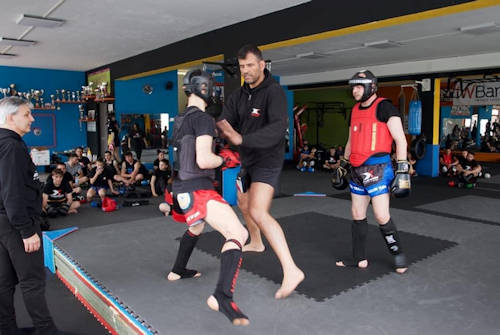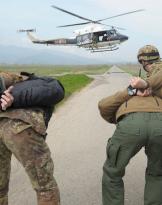While, in these days, yet another controversy flares up in Italy, following the failure of the entire national football team to bow before the start of the match against Wales, which took place last June 20, as a stereotyped form of demonstration against racism and, therefore, of solidarity towards the "Black Lives Matter" movement (apart from the obvious consideration that it is not necessary to bow down to proclaim oneself "anti-racist", and that perhaps even this gesture should be traced back "to the right binari ", due to a fatal fate, it is at least singular the coincidence that, almost concurrently with the aforementioned football match, near the Termini railway station in Rome, it happened that a police officer was to explode a gunshot against a Ghanaian, intent on roaming freely among the people, brandishing a knife and creating terror among passers-by), was issued, just yesterday, by the district court of Hennepin (Minnesota), l a sentence that sanctioned the quantum of the sentence that the former police officer, Derek Chauvin, will have to serve, after the sentence imposed on him last April 21, for the murder of African-American George Floyd1: twenty-two and a half years.
Meanwhile, in the aftermath of the trial a few weeks ago, the aforementioned lawyers had already filed an appeal and asked for a retrial, denouncing the fact, first of all, that their client was denied a fair judgment: jurors who would not been duly isolated by the judge; hypothetical pressure on the latter both by prosecutors and, above all, by public opinion, almost all in favor of a guilty verdict; doubts, again, about the impartiality of some jurors, having, for example, one of them, last year, participated in the 57th anniversary of the march on Washington.
The crucial point on which the entire judicial matter revolved was that concerning the cause of death, that is, whether it could depend on the modalities of the arrest carried out and, in particular, on the technique applied by Chauvin, or if, on the contrary, other causes may have arisen.
 In the end, the prosecution's thesis prevailed, according to which George Floyd died of asphyxiation, due to a lack of oxygen, although, on the one hand, a first autopsy had ruled out this cause.2 (highlighting, however, the possible interaction of the maneuver used by Chauvin with some previous altered health conditions of Floyd, such as problems of heart hypertension and coronary artery disease) and, on the other, the defense of the policeman had tried to demonstrate that, in fact, there could be other causes of death, including carbon monoxide from the police car near which it was landed, left on, drug use and some pre-existing heart problems.
In the end, the prosecution's thesis prevailed, according to which George Floyd died of asphyxiation, due to a lack of oxygen, although, on the one hand, a first autopsy had ruled out this cause.2 (highlighting, however, the possible interaction of the maneuver used by Chauvin with some previous altered health conditions of Floyd, such as problems of heart hypertension and coronary artery disease) and, on the other, the defense of the policeman had tried to demonstrate that, in fact, there could be other causes of death, including carbon monoxide from the police car near which it was landed, left on, drug use and some pre-existing heart problems.
Likewise, the other aspect, supported by the defense, according to which the agent would have been distracted by the crowd which, in the meantime, had become more and more threatening, and from which, therefore, was also worried about having to defend.
The "knee-to-neck maneuver"
The question that many have asked themselves, in the most varied fields, is whether the technique used by the police officer in question could actually have been, in itself, the cause of Floyd's death, to the point that, in the aftermath of that tragic event, various debates immediately arose on whether or not the aforementioned remained in the technical baggage of some police forces for which it was permitted, including that of the same Department of Minnesota, in whose ranks it was in force accused agent.
To the aforementioned (question), we will try, here, to provide an answer, through the opinion of three experts, with the necessary premise that we will not enter into other discourses, which also have little to do with it, and which instead, by some, are were also evoked, such as that of the "Police brutality", or the racial aggravating circumstance that would have been at the basis of that killing, following which there were then various demonstrations (actually, some of them, even very violent) cd " anti-racists ”, both in the United States itself, led by the aforementioned“ Black Lives Matter ”movement, and in various other parts of the world (including, invariably, our country);
 The first of them is from Professor Seth Stoughton, former police officer, current professor of law at the University of South Carolina and author, moreover, of the book "Evaluating Police Uses of Force": this man, right after the tragic killing of Floyd, in an interview with CNN3 appeared in the days immediately following that tragic event, he had to say that, indeed, the technique in question, if badly applied, could be really harmful for the one who suffered it, identifying, in this regard, three ways, in particular: “The first is to put the suspect in a prone position, which is face down and hands crossed behind his back for an extended period of time. This, in fact, can lead to the so-called position asphyxiation. A person in such a situation can still breathe, clearly, or speak in jerks, but cannot do so fully, to the point of gradually losing oxygenation and, consequently, consciousness. The second way is to place excessive weight on the person's neck or head, since this could result in the fracture of the hyoid bone or cervical spine, as appropriate. Lastly, this technique should be applied for the strict time necessary to handcuff the suspect, and therefore not for who knows how long, in the meantime, monitoring the conditions of the suspect who must, however, be well ".
The first of them is from Professor Seth Stoughton, former police officer, current professor of law at the University of South Carolina and author, moreover, of the book "Evaluating Police Uses of Force": this man, right after the tragic killing of Floyd, in an interview with CNN3 appeared in the days immediately following that tragic event, he had to say that, indeed, the technique in question, if badly applied, could be really harmful for the one who suffered it, identifying, in this regard, three ways, in particular: “The first is to put the suspect in a prone position, which is face down and hands crossed behind his back for an extended period of time. This, in fact, can lead to the so-called position asphyxiation. A person in such a situation can still breathe, clearly, or speak in jerks, but cannot do so fully, to the point of gradually losing oxygenation and, consequently, consciousness. The second way is to place excessive weight on the person's neck or head, since this could result in the fracture of the hyoid bone or cervical spine, as appropriate. Lastly, this technique should be applied for the strict time necessary to handcuff the suspect, and therefore not for who knows how long, in the meantime, monitoring the conditions of the suspect who must, however, be well ".
Now, in the specific case, the Minneapolis Police Department allows its officers to proceed in two ways in conducting an arrest with this type of technique, as specified in the relevant operations manual: the first, by applying light pressure on the neck of the arrested subject. , with an arm or a leg, taking care, of course, not to block the airways; the second, on the other hand, by applying greater pressure in such a way as to make the person to be arrested lose consciousness for a few moments, but without, of course, killing him. Method, the latter, to be used only and only if you are faced with a very violent and aggressive person, such as to not be able to be stopped in any other way.
 The second point of view is of the master and champion of martial arts Danilo Capuzi according to which “The technique in question is a posture designed to block a person (a criminal, of course), making him feel enormous pain, precisely in order to be able to better control him. Of course, it does not restrict the air supply to the lungs, nor does it limit the blood supply to the brain.
The second point of view is of the master and champion of martial arts Danilo Capuzi according to which “The technique in question is a posture designed to block a person (a criminal, of course), making him feel enormous pain, precisely in order to be able to better control him. Of course, it does not restrict the air supply to the lungs, nor does it limit the blood supply to the brain.
It pcompletely allows pressure control, which occurs by moving the incidence of the thigh in front of or behind the back of the neck, causing greater or lesser weight to be placed on the person to be controlled (consider that it can be up to eighty percent of the weight of the body of the one who applies it).
It is no coincidence, in fact, that the operator who performs it must have at least one foot on the ground, in order to easily get up. All postures that provide for the control of the person on the ground must be performed holding positions that are dynamic, that is easily changeable (in the case in question, at least from these points of view, the police officer seems to have acted correctly, both because he was straight and he could look around, both because he had, in fact, at least one foot on the ground).
Now, in the knee-to-neck maneuver, the block takes place on the nape of the neck because, as mentioned, it provokes a lot of pain, but it is diametrically opposite to that on the trachea, so there can be no occlusion to breathing. Pressure on the cervicals cannot obstruct the trachea. The very fact that Floyd asks for help, complaining, shows that he could breathe, otherwise he would not have been able to speak. A strangled person cannot speak (on this point, however, the same medical consultant of the accused, David Fowler, had stated that the very fact that Floyd could speak and, in any case, complain, was the demonstration that he had no obstructed airways: ed.4).
The policeman's mistake, if anything, was to ignore the state of malaise that Floyd tried several times to show him: that posture is the best, to keep a person stuck. And if, in general, the person stopped takes drugs or there are other causes that could affect his life, those are other matters, but they are beyond the safety of the aforementioned ".
 The third of the consulted experts, that is the founder of the Special Intervention Group of the Carabinieri, better known as Alpha Commander, who stated that: "In the case of Floyd, clearly I don't know what could have happened, but the technique in question is not, in itself, lethal. We apply it too, as well as several other foreign police forces. It serves to immobilize a person on the ground, time to search her and block her hands with the strings on her wrists and it's all over ".
The third of the consulted experts, that is the founder of the Special Intervention Group of the Carabinieri, better known as Alpha Commander, who stated that: "In the case of Floyd, clearly I don't know what could have happened, but the technique in question is not, in itself, lethal. We apply it too, as well as several other foreign police forces. It serves to immobilize a person on the ground, time to search her and block her hands with the strings on her wrists and it's all over ".
Conclusions
From the above, therefore, it seems possible to conclude that the technique used by Chauvin against Floyd is not, in itself, and in general, lethal, nor, probably, would have been in the specific case, if it had been correctly applied not so much in the posture (which, from the videos found on the net, seems correct), as in the "timing", ie in the time for which the aforementioned lasted. As mentioned, in fact, if this (technique) can be considered very effective for immobilizing a thug, it must however be applied correctly (for which, of course, the necessary training and, later, training is also important) and for the right time: that is, a few seconds, and then, once the stopped subject has been made safe, immediately place him in another "safe" position.
4 https://www.abc.net.au/news/2021-04-15/floyd-trial-defence-claims-heart-...
Photo: Facebook / web / Arma dei Carabinieri












